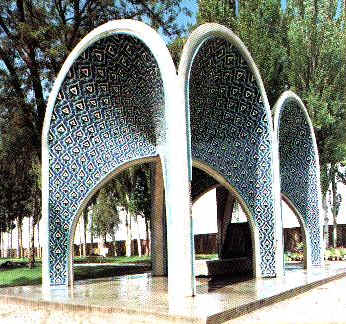|
|
Located North of Khorasan, Neishabour covers an area of 9248 square Kilometers.
It is limited Northward by Binalood mountains and Qouchan, Westward by Esfarayen and Sabzevar, Westward by Meshed, and Southward by Torbat Heidarieh and Kashmar. Neishabour enjoys seasonal rivers, the major of them is Kalshour.
It has a variable climate. Its well-watered valleys and green foothills in Northern areas enjoy a temperate climate, whereas its southern areas have a relatively warm and desert climate.
Neishabour includes 2 cities, 5 districts, 15 villages and 632 hamlets. According to the census of 1991, it had a population about 400,000 persons.
Neishabour includes historical monument and mausoleums of the celebrated persons such as Hakim Omar Khayam, Attar Neishabour, Kamalolmolk, Imamzadeh Mahrouq and Ibrahim, Fazlollah Shazan and Said Salam Maghrebi. Besides, it enjoys mountainous sites and summer quarter; the most picturesque of them are Doroud, Kharn, Garineh, bar, Soumeh, Kelider, Bouzhan, Ghar, Roud, Mirabad, Hesar and Barfriz.
Covering an area of several hectares, international camp of Baqrud is located 12 km North of Neishabour. Having over 5000 visitors in a day, it is second camp of Iran.
Several traditional gardens are also situated inside and outside of Neishabour, among them Neshat garden, in Taqiabad village, Kamalolmolk's home in Hosseinabad village, Amin Eslami garden, Qavami garden and Jamshid garden, inside the city.
History of Neishabour
located on the Silk-Road, Neishabour is one of the most ancient cities of Iran. It dates back to the Sasanid monarch, Shapour 1. According to recent archaeological discoveries, Neishabour shared in trade with the valley of Indus river in Pakistan and the area of Mesopotamia in the 3rd millennium BC.
Recently significant ancient sites, dating to the 3rd and 4th millennium BC, were discovered around the city. It seems that the most ancient evidence related to Neishabour is an inscription known as “Kabe Zartosht” (Kaba of Zoroaster).
Dating in origin from the reign of Shapour 1, it was called “Tamam Aparakhshtar”. One of the most important pre-historic fire-temples, known as “Azar-Barzin-Mehr”, was located in Neishabour, which was dedicated to farmers. It was formerly named “Abarshahr”, but from the Islamic period onwards its name changed into Neishabour.
In the time of Abdollah Ebne Taher, Neishabour served as a capital and gradually grew in importance.
After the fall of the Taherid dynasty, Saffarids adopted it as a capital. Under the Qaznavids and Saffarids, It was brought to a peak and changed to the wealthiest and most populated areas. Soon after it razed to the ground, owing to the Mongol invasion. A new city was built on the North-western boundary of the old one, shortly after, due to which city flourished again. It was devastated by an earthquake in 15th century.
Neishabour rose to importance under Timurid dynasty and grew in size and splendor.

Kamalolmolk
|
|

